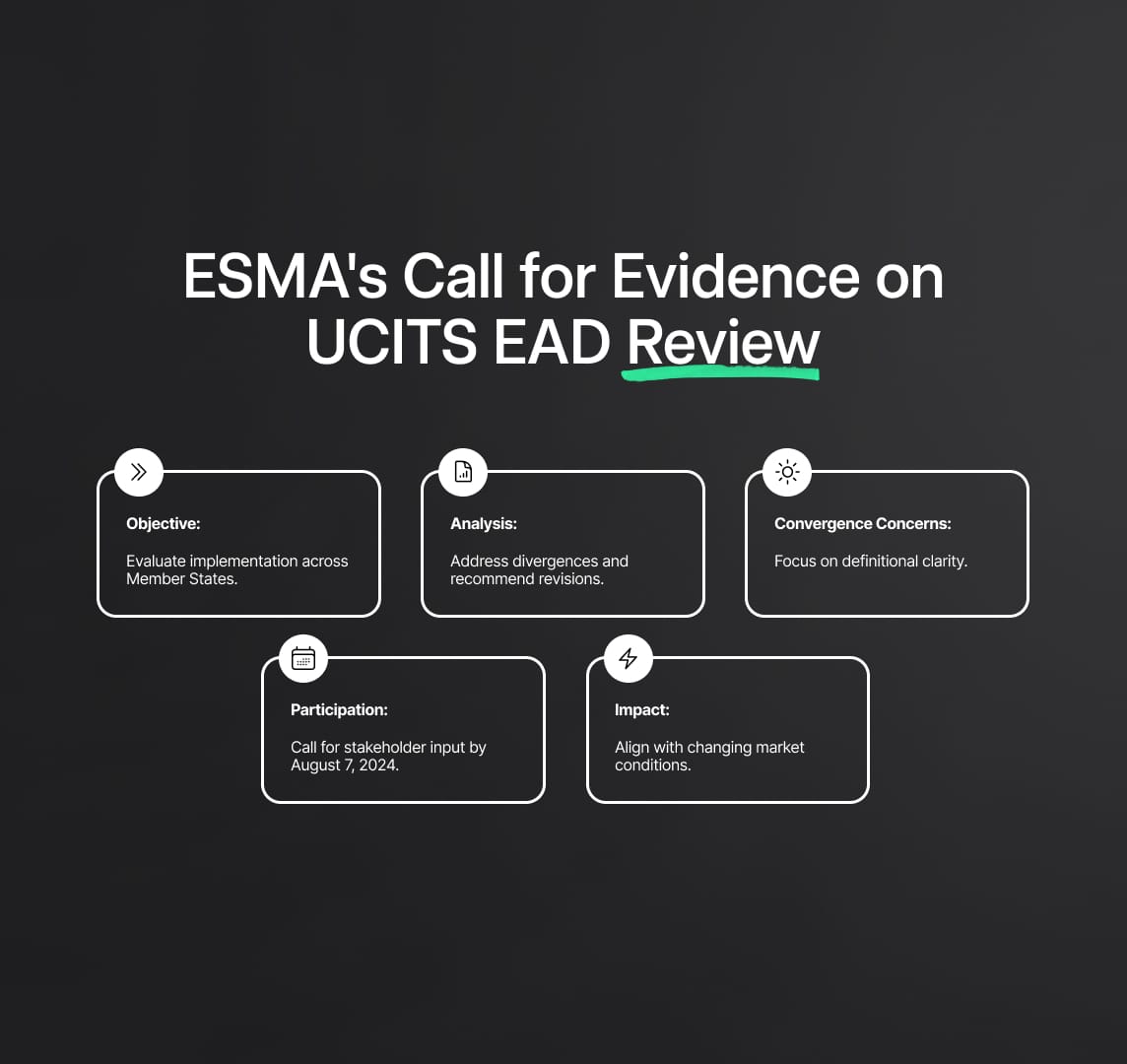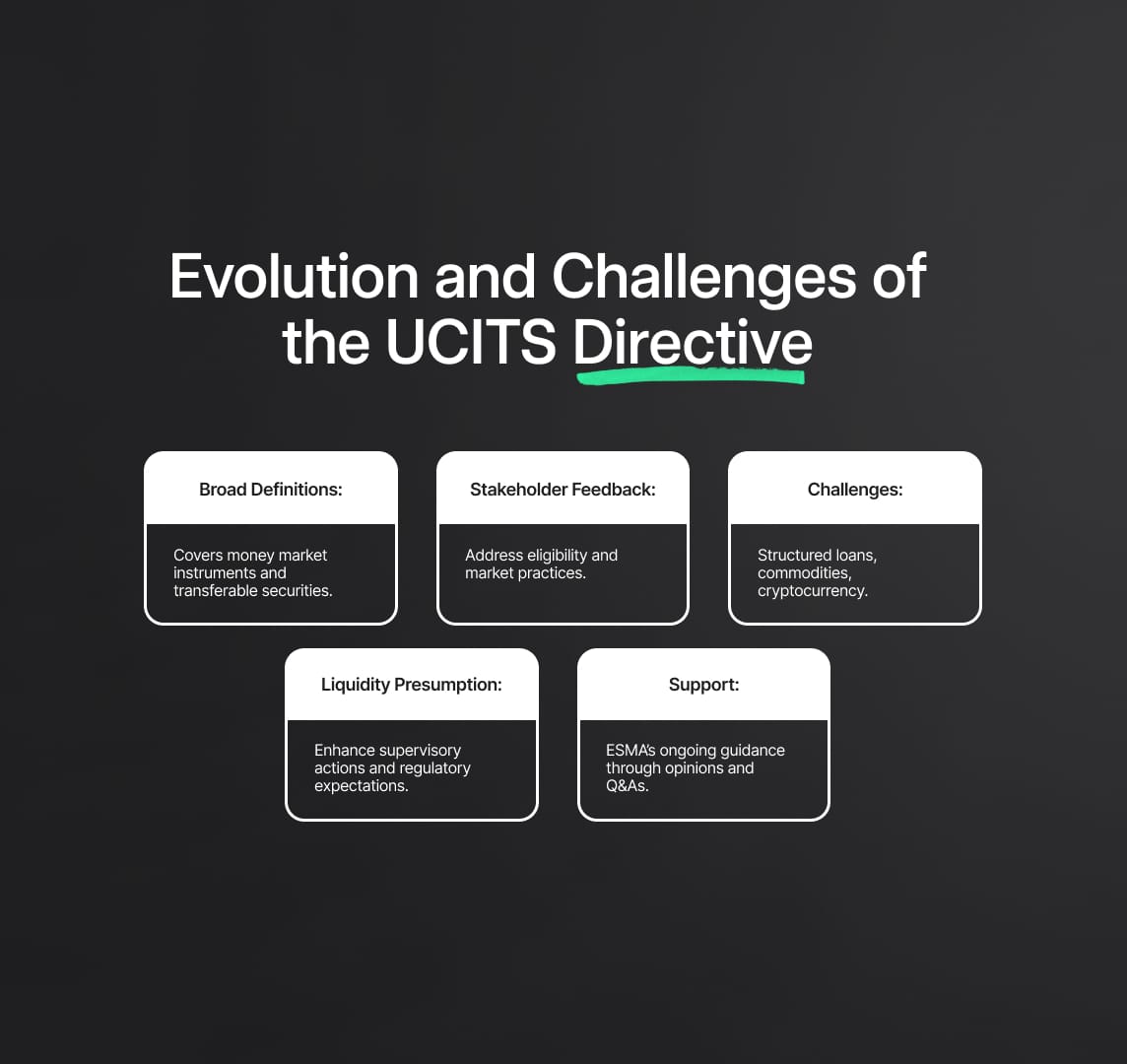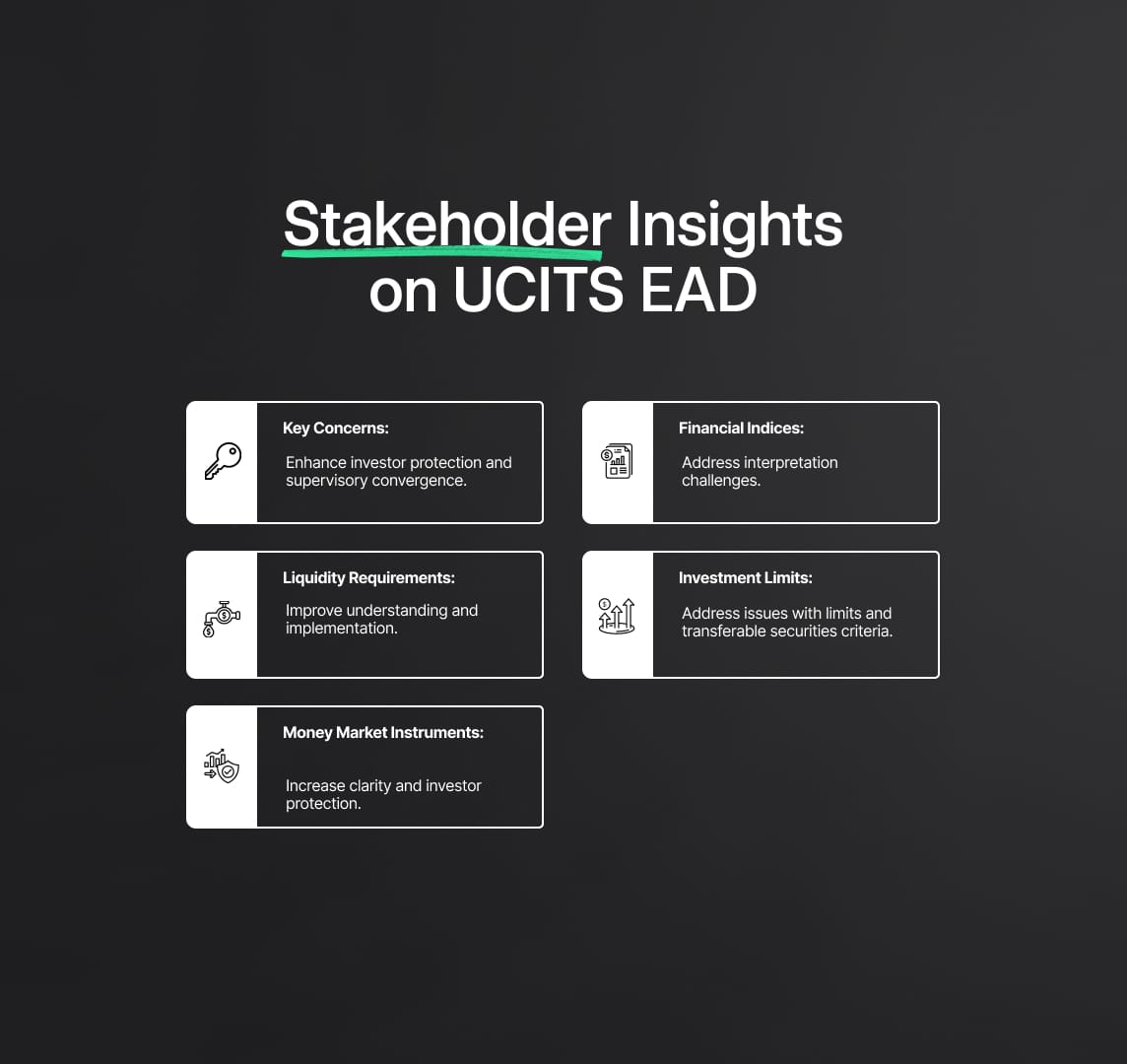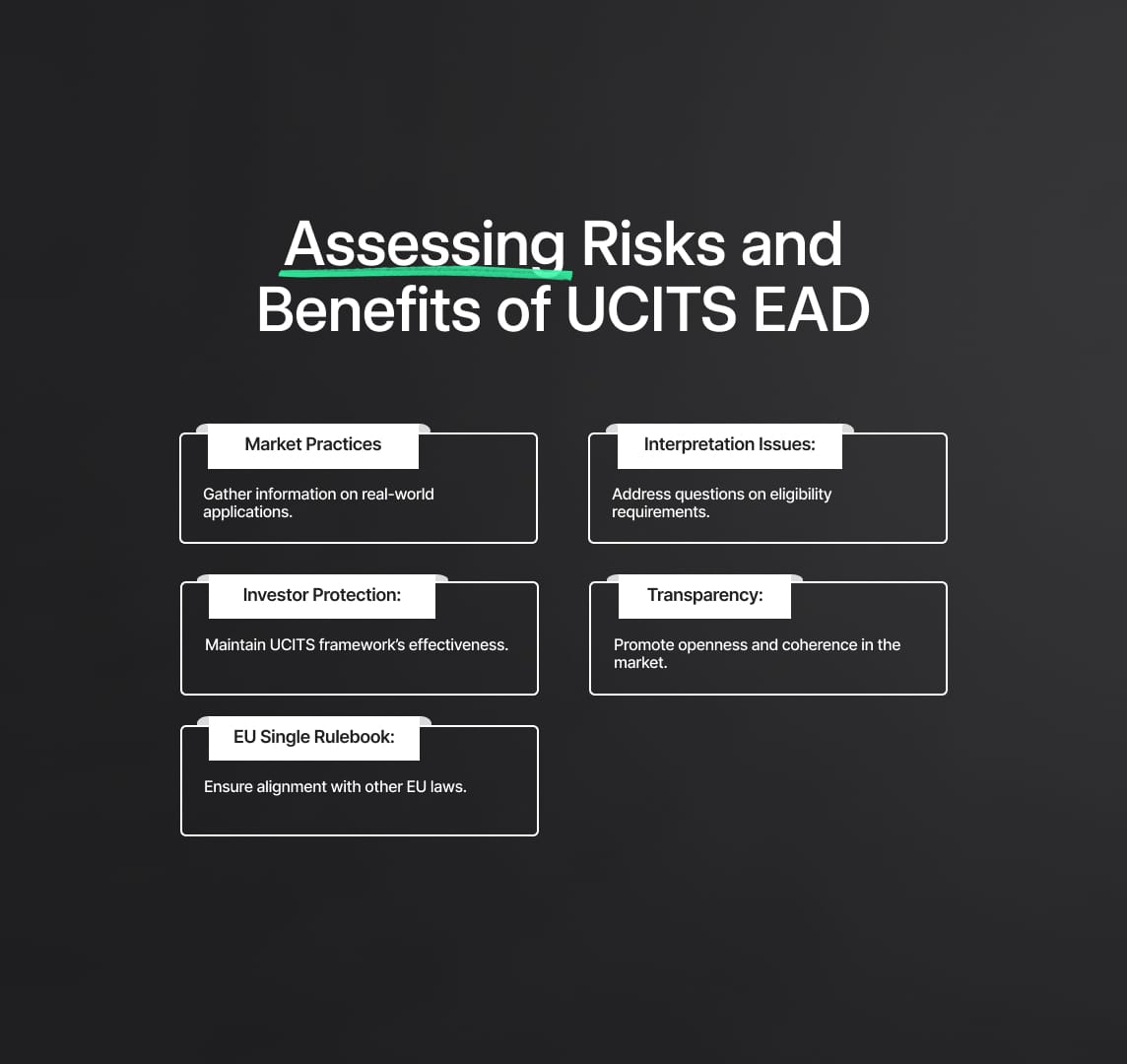UCITS Eligible Assets Directive
ESMA calls for evidence on UCITS EAD review to assess risks & benefits of UCITS exposure to diverse assets. Mandated by EU, ESMA aims to analyze implementation, address divergences & recommend revisions for market alignment.

By releasing a request for evidence to review the UCITS Eligible Assets Directive on May 7, 2024, ESMA made a big step toward evaluating the possible risks and advantages of UCITS exposure to a variety of asset classes. Under a mandate from the European Commission, ESMA's goal is to assess how the directive is being implemented in each Member State, find any differences, and provide recommendations to guarantee conformity with changing market conditions. The call for evidence, which is divided into many categories, asks interested parties to provide supporting documentation by August 7, 2024, on convergence concerns, definitional clarity, and direct and indirect UCITS exposures to various asset classes.

Understanding the Evolution and Challenges of the UCITS Directive
The UCITS Directive, which was created in 1985 and has since been amended, sets down the permissible assets that UCITS funds may invest in. It does this by use broad definitions such as "money market instruments" and "transferable securities." To improve understanding of these ideas, the European Commission introduced the UCITS EAD in 2007. Since 2011, ESMA has offered advice in the form of opinions, recommendations, and Q&As. These have mostly dealt with ETFs and EPM methods. The emergence of uncertainty in relation to the eligibility of some instruments in the financial markets has prompted ESMA to request feedback from stakeholders on matters of interpretation and market practices pertaining to the UCITS EAD. Determining what constitutes an eligible asset and distinguishing between derivatives and financial products backed by assets are two challenges. Structured loans, commodities, and cryptocurrency assets provide particular difficulties. In addition, the call discusses the presumption of liquidity and negotiability with the goal of enhancing supervisory actions and regulatory expectations.

UCITS EAD: Stakeholder Insights
This area provides a forum for stakeholders to share their thoughts and observations about the lucidity of important ideas as well as possible ambiguity and convergence problems related to the implementation of the UCITS Eligible Assets Directive (UCITS EAD). The following questions aim to promote a deeper understanding of difficulties and potential improvements in investor protection, clarity, and supervisory convergence within the European Union. They are based on past workstreams done by ESMA and concerns expressed by stakeholders:
- Important Concerns in UCITS EAD: In order to improve investor protection, clarity, and supervisory convergence, stakeholders are asked to discuss the important concerns in the UCITS EAD.
- Financial Indices Interpretation Challenges: Stakeholders are requested to outline any recurrent or noteworthy problems with the interpretation or application of UCITS EAD regulations pertaining to financial indices, as well as suggest changes to resolve these challenges.
- Problems with Money Market Instruments: In order to increase clarity and investor protection, stakeholders are invited to identify any persistent or important problems they may have while understanding or implementing the UCITS EAD regulations pertaining to money market instruments.
- Recognizing Liquidity Requirements: Stakeholders are invited to talk about any difficulties in interpreting or implementing the liquidity-related rules of the UCITS EAD and to suggest changes that will improve clarity and investor protection.
- Evaluation of Presumption of Liquidity: Taking into account alterations in market conditions, stakeholders are requested to express their opinions regarding the suitability of the UCITS EAD's presumption of liquidity and negotiability as well as any potential ramifications of doing away with it.
- Views on accessory Liquid Assets and Foreign Currency Holdings: Participants are asked to share their perspectives on what constitutes accessory liquid assets and whether or not UCITS may purchase or hold foreign currency for investment purposes while taking depreciation and volatility into account.
- Issues with Investment Limits and Transferable Securities Criteria: Stakeholders are prompted to describe any recurring or significant issues encountered with investment limits and transferable securities criteria set out in the UCITS EAD and propose amendments for clarity and investor protection.
- Clarity on Valuation and Risk Management Criteria: Stakeholders are encouraged to discuss the interpretation and application of valuation and risk management criteria outlined in the UCITS EAD and suggest improvements to enhance clarity and supervisory convergence.
- Assessment of Investments in Financial Instruments: Stakeholders are asked to assess the adequacy and clarity of UCITS EAD provisions on investments in financial instruments backed by, or linked to, assets other than those listed in the UCITS Directive.
- Understanding Embedded Derivatives: In order to promote clarity and investor protection, stakeholders are encouraged to address any concerns regarding the application or interpretation of the embedded derivatives concept in the UCITS EAD.
- Treatment of Delta-One Instruments: In order to enhance investor protection, clarity, and supervisory convergence, stakeholders are asked to provide comments and offer specifics regarding the evaluation of the eligibility of various delta-one instrument types under the UCITS EAD.

UCITS Eligible Assets Directive: Assessing Risks and Benefits
A Call for Evidence has been released by the European Securities and Markets Authority (ESMA) on the review of the Eligible Assets Directive (EAD) for Undertakings for Collective Investment in Transferable Securities (UCITS). This call is intended to gather input from interested parties, such as investors, consumer advocacy organizations, UCITS management firms, and trade associations, in order to assess the possible advantages and disadvantages of UCITS exposure to different asset classes. The purpose of ESMA is to collect information on market practices, questions of interpretation, and real-world applications pertaining to the eligibility requirements and other clauses contained in the UCITS EAD. To maintain transversal coherence among regulations, ESMA also requests input on important concepts and definitions found in the UCITS EAD and their alignment with other laws in the EU Single Rulebook.

Investor Protection: The Significance of Reviewing the UCITS EAD
It is crucial to examine the EU's Eligible Assets Directive (EAD) for Undertakings for Collective Investment in Transferable Securities (UCITS) in order to protect investor interests and preserve the integrity of retail investment products. UCITS, the main retail investment instrument, are important since they make up around 75% of all retail investors' collective investments. UCITS's reputation for reliability and strict control across the globe is based on its strong oversight and regulation, which guarantees a high degree of investor protection. But given how the financial markets are developing and how many different kinds of financial instruments are available, it is imperative that the eligibility requirements listed in the UCITS EAD be reviewed.
Divergent interpretations and market practices have resulted from the rising complexity of financial instruments, which has created ambiguity regarding their eligibility for investment. With the goals of preserving the UCITS framework's effectiveness, improving investor protection, and preserving the caliber of investment products made available to retail investors, ESMA's technical guidance on the UCITS EAD review aims to solve these issues. The UCITS EAD review aims to maintain investors' trust and confidence in the UCITS framework by promoting openness, coherence, and alignment with changing market circumstances.
Reduce your
compliance risks

